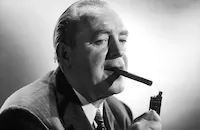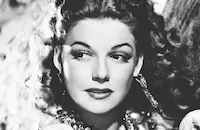In addition to testing new talent, shorts were frequently used to try out technical innovations. Animation, stop-motion photography and time-lapse photography all turned up first in shorts before being used in feature films. The same holds true for Technicolor. After pioneering by producing the first all-talking two-strip Technicolor feature, On with the Show (1929), Warner Bros. used its Vitaphone shorts division to release the first live-action film using the new three-strip process, Service with a Smile (1934), which debuted on July 28, 1934. The short starred Leon Errol who ran a service station staffed entirely by chorus girls, providing an excuse for colorful production numbers. The studio would spend four years working with the Technicolor Corporation on shorts, including the three featured in this program, before releasing its first three-strip Technicolor feature, The Adventures of Robin Hood (1938).
For its second three-strip Technicolor short, Warner Bros. brought back Errol to star as a decidedly eccentric version of Adam, dressed in fig leaves and spats, in Good Morning, Eve (1934), released just days after the earlier Technicolor short. At the urging of Eve (June MacCloy), he takes a bite of the apple, but instead of being banished from Eden it sends them on a trip into the future. They stop for musical interludes in Nero's Rome, King Arthur's England and a modern beach party, complete with the scantiest swimwear the pre-Code era would allow. The film is usually credited as the first, but the Oscar®-winning La Cucaracha (1934), actually premiered a few weeks later.
There was less music but more farce in the 1935 Okay, Jose. El Brendel stars as a Swedish salesman on vacation in Mexico, where he's arrested under suspicion of having helped a notorious bandit escape. He sweet talks the police into letting him go so he can capture the bandit on his own, setting the stage for more comic action. Warner Bros. had stolen Brendel from Fox a few years earlier and put him to work playing supporting roles in features and leading roles in Vitaphone shorts. Those made good use of his trademark dialect humor, which he had developed through years of stage work. In addition to his comic shenanigans, Okay, Jose featured some impressive Technicolor landscapes to help set the location in Mexico.
By 1938, Warner Bros. was ready to start producing Technicolor features, a fact they promoted with the short Out Where the Stars Begin (1938). Ostensibly about a young dancer (Evelyn Thawl) hoping to break into the movies, the picture is really a 19-minute commercial for the studio. It features cameos by Warner stars Pat O'Brien, Ann Sheridan, Wayne Morris and Dick Foran, and references to upcoming films, with scenes shot on the set for Jezebel (1938) and the studio's New York street and clips from Adventures of Robin Hood and Gold Is Where You Find It, the studio's two Technicolor features for 1938.
This was the only screen credit for Thawl, whose only other film appearance was an uncredited bit in Gold Diggers in Paris (1938). She would return to Broadway to star in the Jerome Kern-Oscar Hammerstein II musical Very Warm for May before dying at the age of 30 in 1945. Lynn, who makes his film debut as the unnamed makeup artist, was destined for greater things at Warner's, where he would achieve stardom as one of the suitors in Four Daughters (1938). The film, however, belongs to Fritz Feld, a German-born character comic cast as a temperamental European director intended as a take-off on Warner's resident directorial tyrant, Michael Curtiz. When his leading lady walks out after a fight, it sets the stage for Thawl to impress in two numbers, pulling off both a balletic solo and a spirited tap number.
Of course, the real star of the film is Technicolor. With its back lot setting, Where the Stars Begin gives an idea of what the studio's lavish musicals might looked like in three-strip Technicolor. Sadly, Warner was reaching the end of its musical cycle by 1938. With the studio making only two Technicolor films a year at first, it would be eight more years before Warner Bros. released a three-strip Technicolor musical feature, with the fanciful Cole Porter biographyNight and Day (1946).
By Frank Miller
Good Morning, Eve!
Director: Roy Mack
Screenplay: Cyrus Wood, Eddie Moran, A. Dorian Ovos
Cinematography: Ray Rennahan
Score: Cliff Hess
Cast: Leon Errol (Adam), June MacCloy (Eve), Vernon Dent (Nero), Maxine Doyle (Queen Gwinivere), Bill Elliott (Sir Lancelot), Harry Seymour (Harold)
Okay, Jose
Director: Ralph Staub
Screenplay: Joe Traub
Cinematography: William V. Skall
Score: Howard Jackson
Cast: El Brendel (Knute Knudsen), Sam Appel (Henchman Lookout), Chris-Pin Martin (Lookout Guard), Frank Puglia (Comandante Capitan Lopez), Julian Rivero (Jose Pedro Carlos Hernandez II), Joan Woodbury (Dancer)
Out Where the Stars Begin
Director: Bobby Connolly
Screenplay: Jack Henley, Dolph Singer
Cinematography: Edwin B. DuPar
Cast: Evelyn Thawl (Sally Carter), Jeffrey Lynn (The Makeup Artist), Armida (Argumentative Dancer), Fritz Feld (Mr. Nitvitch), Charley Foy (Sammy Kane), Dick Foran, Wayne Morris, Pat O'Brien, Ann Sheridan (Themselves)
Out Where the Stars Begin
Brief Synopsis
This spoofs the production of Hollywood movies.
Cast & Crew
Read More
Bobby Connolly
Director
Fritz Feld
Dick Foran
Himself
Armida
Wayne Morris
Himself
Jack Mower
Film Details
Genre
Short
Comedy
Music
Musical
Release Date
1938
Production Company
Vitaphone; Warner Bros. Pictures
Distribution Company
Warner Bros. Pictures
Technical Specs
Duration
19m
Synopsis
This spoofs the production of Hollywood movies.
Director
Bobby Connolly
Director
Film Details
Genre
Short
Comedy
Music
Musical
Release Date
1938
Production Company
Vitaphone; Warner Bros. Pictures
Distribution Company
Warner Bros. Pictures
Technical Specs
Duration
19m
Articles
Vitaphone in Technicolor

Vitaphone in Technicolor
In addition to testing new talent, shorts were frequently used to try out technical innovations. Animation, stop-motion photography and time-lapse photography all turned up first in shorts before being used in feature films. The same holds true for Technicolor. After pioneering by producing the first all-talking two-strip Technicolor feature, On with the Show (1929), Warner Bros. used its Vitaphone shorts division to release the first live-action film using the new three-strip process, Service with a Smile (1934), which debuted on July 28, 1934. The short starred Leon Errol who ran a service station staffed entirely by chorus girls, providing an excuse for colorful production numbers. The studio would spend four years working with the Technicolor Corporation on shorts, including the three featured in this program, before releasing its first three-strip Technicolor feature, The Adventures of Robin Hood (1938).
For its second three-strip Technicolor short, Warner Bros. brought back Errol to star as a decidedly eccentric version of Adam, dressed in fig leaves and spats, in Good Morning, Eve (1934), released just days after the earlier Technicolor short. At the urging of Eve (June MacCloy), he takes a bite of the apple, but instead of being banished from Eden it sends them on a trip into the future. They stop for musical interludes in Nero's Rome, King Arthur's England and a modern beach party, complete with the scantiest swimwear the pre-Code era would allow. The film is usually credited as the first, but the Oscar®-winning La Cucaracha (1934), actually premiered a few weeks later.
There was less music but more farce in the 1935 Okay, Jose. El Brendel stars as a Swedish salesman on vacation in Mexico, where he's arrested under suspicion of having helped a notorious bandit escape. He sweet talks the police into letting him go so he can capture the bandit on his own, setting the stage for more comic action. Warner Bros. had stolen Brendel from Fox a few years earlier and put him to work playing supporting roles in features and leading roles in Vitaphone shorts. Those made good use of his trademark dialect humor, which he had developed through years of stage work. In addition to his comic shenanigans, Okay, Jose featured some impressive Technicolor landscapes to help set the location in Mexico.
By 1938, Warner Bros. was ready to start producing Technicolor features, a fact they promoted with the short Out Where the Stars Begin (1938). Ostensibly about a young dancer (Evelyn Thawl) hoping to break into the movies, the picture is really a 19-minute commercial for the studio. It features cameos by Warner stars Pat O'Brien, Ann Sheridan, Wayne Morris and Dick Foran, and references to upcoming films, with scenes shot on the set for Jezebel (1938) and the studio's New York street and clips from Adventures of Robin Hood and Gold Is Where You Find It, the studio's two Technicolor features for 1938.
This was the only screen credit for Thawl, whose only other film appearance was an uncredited bit in Gold Diggers in Paris (1938). She would return to Broadway to star in the Jerome Kern-Oscar Hammerstein II musical Very Warm for May before dying at the age of 30 in 1945. Lynn, who makes his film debut as the unnamed makeup artist, was destined for greater things at Warner's, where he would achieve stardom as one of the suitors in Four Daughters (1938). The film, however, belongs to Fritz Feld, a German-born character comic cast as a temperamental European director intended as a take-off on Warner's resident directorial tyrant, Michael Curtiz. When his leading lady walks out after a fight, it sets the stage for Thawl to impress in two numbers, pulling off both a balletic solo and a spirited tap number.
Of course, the real star of the film is Technicolor. With its back lot setting, Where the Stars Begin gives an idea of what the studio's lavish musicals might looked like in three-strip Technicolor. Sadly, Warner was reaching the end of its musical cycle by 1938. With the studio making only two Technicolor films a year at first, it would be eight more years before Warner Bros. released a three-strip Technicolor musical feature, with the fanciful Cole Porter biographyNight and Day (1946).
By Frank Miller
Good Morning, Eve!
Director: Roy Mack
Screenplay: Cyrus Wood, Eddie Moran, A. Dorian Ovos
Cinematography: Ray Rennahan
Score: Cliff Hess
Cast: Leon Errol (Adam), June MacCloy (Eve), Vernon Dent (Nero), Maxine Doyle (Queen Gwinivere), Bill Elliott (Sir Lancelot), Harry Seymour (Harold)
Okay, Jose
Director: Ralph Staub
Screenplay: Joe Traub
Cinematography: William V. Skall
Score: Howard Jackson
Cast: El Brendel (Knute Knudsen), Sam Appel (Henchman Lookout), Chris-Pin Martin (Lookout Guard), Frank Puglia (Comandante Capitan Lopez), Julian Rivero (Jose Pedro Carlos Hernandez II), Joan Woodbury (Dancer)
Out Where the Stars Begin
Director: Bobby Connolly
Screenplay: Jack Henley, Dolph Singer
Cinematography: Edwin B. DuPar
Cast: Evelyn Thawl (Sally Carter), Jeffrey Lynn (The Makeup Artist), Armida (Argumentative Dancer), Fritz Feld (Mr. Nitvitch), Charley Foy (Sammy Kane), Dick Foran, Wayne Morris, Pat O'Brien, Ann Sheridan (Themselves)


















